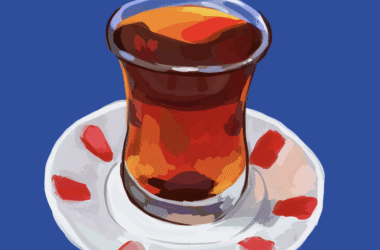
As I trudged by a workshop on Mill Street in the pouring rain, a kind-eyed, pony-tailed glassblower stared at me. He wore an expression of shock and sympathy, holed up in his abode of warm kilns and red-hot vases. I had little time to stop and commiserate, so I pushed through the growing puddles. I was almost at my destination, the once-thriving riverside Goose Village.
I had already passed under Autoroute Bonaventure—the traffic artery of Montreal’s Centre Ville—skirted a crumbling but functional distillery, and left the old Ogilvie’s Flour Mill behind me. Up ahead I saw a behemoth Costco at a crossroads filled with traffic departing and entering the city from Pont Victoria. Passing a wind-battered Chinese depanneur, I reached Bridge Street quickly, once the heart of a vibrant neighborhood of Italian, Irish, Polish, and Ukrainian immigrants.
Goose Village got its name from the waterfowl that once occupied the banks of the St. Lawrence at this spot. First Irish immigrants, then Italians, built the little village into a community by the end of the 19th century, and into the 1960s the area pulsed with Catholic fervor and neighborly vivacity. At the height of its growth, Goose Village took up the space due west of the Old Port and south of Rue Notre Dame, running all the way to the St. Lawrence River. However, in the 1960s things changed—or rather, they were forced to change—and quickly.
In the years before Expo 67, Mayor Jean Drapeau led a campaign to purge Montreal of what might be perceived as blights by outside visitors. Goose Village suffered mightily. Residents were informed that the area was to be bulldozed; since its poor (yet energetic) streets were among the first to be seen by cars entering downtown from both major bridges, the “blight” had to go.
Now, over fifty years later, the kind-eyed glassblower was not simply astonished at my slog through the tempest, but rather that I was going to Goose Village at all. But I wished to see what was left. Were there any resilient mom-and-pop corner stores or toddlers plodding the streets, jumping in muddy puddles?
The journey started off promisingly enough. Exiting Griffintown (just northeast of Goose Village), there remained costume shops for nightlife masqueraders, and satisfied young professionals alighted the decks of bistros, umbrellas in hand. A residential atmosphere was recognizable.
The feeling hardly lasted. Heading down Duke Street, a graffitied shack clung to the side of a vacant brick tenement building. Crossing the Lachine Canal onto Mill Street, the civilized city seemed to recede behind the clouds and the gray industrialism of the waterfront. Although wind and rain kept denizens off the street that day, I had the eerie feeling that a balmy, sunny afternoon would have brought out no more than one or two.
I stood at the Costco crossroads, momentarily disheartened. Traffic whizzed shoppers away from the megastore. A cop perched his car on a median, slowing traffic. But there was one last saving grace whose timelessness I had to sequester, and from what I had heard, it was just down the street.
Down Bridge Street I trudged, crossing overgrown train tracks, and there it was: the massive, rugged, jagged Black Rock. The rock is a memorial, erected in 1859 to honour thousands of Irish immigrants who had died there of typhus in small shacks ten years prior. For years it has stood as the pride of the Irish community, and for Goose Village, those who survived went on to build a flourishing, homey neighborhood. Now, the rock is solitary yet comforting, with an empty green hill and tumbledown shacks in the background.
If you go to old Goose Village, there are glimmers amongst the grayness. The Espace Verre glassblowers run three exhibitions each year. Take the Lachine Canal bike paths from the Old Port to Atwater Market (on a sunnier day), or if you find yourself milling about Griffintown, simply satisfy your curiosity and go see the relic of Goose Village next door.






